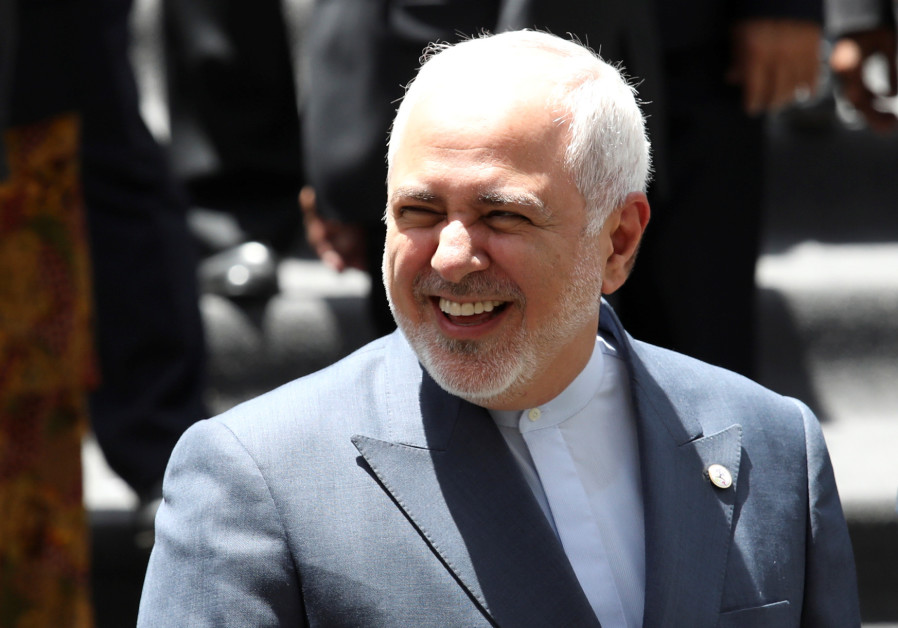Sanctioning Zarif: Iran’s smiling chief explainer – analysis

Iran’s Foreign Minister Mohammad Javad Zarif after posing for a family photo during the Ministerial Meeting of the Non-Aligned Movement (NAM) Coordinating Bureau in Caracas, Venezuela July 20, 2019. (photo credit: MANAURE QUINTERO/REUTERS)
The US took the unusual, but anticipated, step of sanctioning Iran’s Foreign Minister on Wednesday evening. The US says that Javad Zarif is the “chief apologist” of the regime. Zarif responded by saying that the sanctions will have no affect on him and mocked the US for considering him a threat.
Sanctioning Zarif is part of increasing attempts by Washington to ratchet up pressure on Tehran. It began by leaving the Joint Comprehensive Plan of Action, or Iran Deal, last May. Then the US slapped increased sanctions on Iran, designed to bring its oil exports to near zero. This “maximum pressure” campaign was led by a new appointment at the State Department, Brian Hook, who was named in August 2018 and tasked with coordinating efforts against Tehran.
This year the team around US President Donald Trump began to move on new targets, sanctioning the Islamic Revolutionary Guard Corps (IRGC) in April and sanctioning the Supreme Leader Ayatollah Ali Khamenei in June. During that time the US also warned Iran against attacks in May and sent naval and air assets to the Gulf. Nevertheless Iran responded with allege sabotage of tankers and Iranian allies used drones and rockets against Saudi Arabia and fired near US bases in Iraq. Iran also grabbed a UK oil tanker in response to the UK seizing an Iranian tanker in July.
The sanctions against Zarif were anticipated and some thought they would come in June. But the US was waiting to see and also wanted to keep more card in its deck. Ostensibly sanctioning Zarif means the US demand for a new Iran deal will be more difficult. How can you get a new deal if you sanction the dealmaker? But the current US administration thinks that Zarif is pernicious because he is the smiling face and chief explainer of Iran. This is clear from the course he charts in Europe and even the desire by the US to restrict his movements to a small radius around the UN in New York in a July visit. In the past he has used trips to the US as an opportunity to appeal directly to the American people and high level Democrats. He is seen as a threat therefore, cultivating his own lobbying apparatus.
In Iran meanwhile the goal is to pressure the Europeans to do more for Iran by walking away from key parts of the Iran deal. Iran wants sanctions relief and it wants to continue its policies in Iraq, Syria, Lebanon and Yemen. It also wants to show it means business in the Gulf. That is why it sent fast boats and a helicopter to grab a British ship almost under the nose of t he Royal Navy.
Sanctioning Zarif is an important next step by Trump’s team, but with each step they appear to make it more difficult to come back. You can’t just magically un-sanction someone or undesignated an entity that you labelled a terrorist group. So what comes next with Zarif. The concept is to reduce his ability to influence the US, that means reducing his media presence and the way Iran tends to play the “good cop, bad cop” game of moderates and hardliners when speaking to foreign media and officials. It also means Iran has less of an ability to exploit the democratic nature of other regimes by cultivating think tanks and policy allies from opposition politicians in the US or the West and simply waiting until they come to power. Iran had become an expert at this in recent years, while denying western diplomats the ability to do the same in Iran, even reducing western media presence in Iran.
Join Jerusalem Post Premium Plus now for just $5 and upgrade your experience with an ads-free website and exclusive content. Click here>>






Comments are closed.